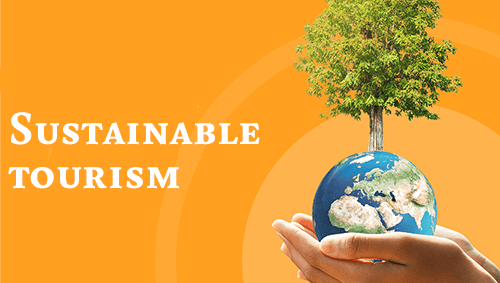Sustainable Tourism
Getting on to tour, experiencing newness in life had never been as organised as it is today. The gratitude goes to the well organised tourism trade organisations labeled travel agencies and tour operators; as well as to the well established and upcoming educational institutions offering courses in tourism management. The professional uprising in this more or less trivialised arena has helped in facilitating comfortable or hassle free experiences of travel and visitation to new destinations. This transformation has however brought a little or no change to the unplanned approach of tourism development of the destinations which brings forth a series of repercussions of adversities to the environment, economy and socio-cultural fabric of the destination. The adverse fallouts when become conspicuous are realized and become an issue to talk upon in academic deliberations. In these intellectual meets sustainable tourism is extensively discussed and emerges as the antidote for negative impacts of unplanned tourism.
Sustainable tourism is an approach for sustainable development in the realm of tourism. Sustainable tourism as stated by UNWTO is “meeting the needs of present generation without compromising the ability of the future generation to meet their needs”. This is about adopting “Triple Bottom Line” approach where environment, socio-cultural features of any business plan is well integrated with its economic outcomes. The concept has been well established and well discussed in academics as a subject. But unfortunately this has not become the cherry pick for those who are at the helm of affairs taking planning decisions for destination development. This is apparent when there appears news eulogizing the so called achievement by proclaiming rise in number of visitors. This myopic vision of the developers of tourism gives a pain and grief to those who understand the prognosis of this quantity focused approach of tourism development.
The need for sustainable tourism is for giving quality experience to the two main stakeholders namely visitors or tourists; and to the local community. The high figure in number is an apple of eye for those who have in mind-business, profit, money and income and no vision for what havoc the high numeric values can have on the environment and socio-cultural features of the communities.
Operating tourism operations beyond the carrying capacities of the tourism destination takes tourism to the verge where “tourism kills tourism” because the virginity of the resources of physical environment and purity of the cultural resources is put at stake by implementation of the poor planning based on the misunderstood planning premises devoid of taking account of proper forecasting that is the quality of looking into the future; and absence of generating a number of alternatives against the requisite criterias for the final selection of the most suitable alternative to meet the objectives of Sustainable Tourism Development. Moreover, there is a lack of control measures to monitor the implementation.
There is a need for change in the mindset of those who have applied the purist concept of growth. The change cannot be expected until the learning outcomes of those who fathom the dimensions of Sustainable Tourism Development are shared with those who are at the helm of affairs.
The industry-academia interface has been recognised as an important feature of concern in the context of the demand and supply. There is an equal need for Government-academia interface in the form of promotion of consultancy services of the academic institutions to the Government sector so that the knowledge that is highly important for the survival and perpetuality of the mother earth may not remain confined within the walls of the academic institutions. Consultancy into the sustainable tourism development can help capturing the essential elements of planning that would help gaining equilibrium and providing sustainable tourism as antidote for the development for tourism destinations.
(The author is Assistant Professor, Department of Tourism and Travel Management, Central University of Jammu)

